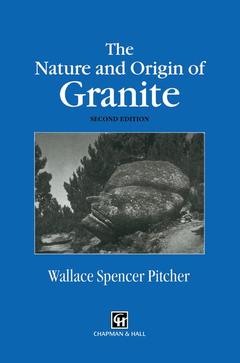The Nature and Origin of Granite (2° Éd., 2nd ed. 1997)
Langue : Français
Auteur : Pitcher W.S.

The origin of granite has for long fascinated geologists though serious debate on the topic may be said to date from a famous meeting of the Geological Society of France in 1847. My own introduction to the subject began exactly one hundred years later when, in an interview with Profes sor H. H. Read, I entered his study as an amateur fossil collector and left it as a committed granite petrologist - after just ten minutes! I can hardly aspire to convert my reader in so dramatic a way, yet this book is an attempt, however inadequate, to pass on the enthusiasm that I inherited, and which has been reinforced by innumerable discussions on the outcrop with granitologists of many nationalities and of many shades of opinion. Since the 1960s, interest in granites has been greatly stimulated by the thesis that granites image their source rocks in the inaccessible deep crust, and that their diversity is the result of varying global tectonic context. So great a body of new data and new ideas has accumulated that my attempt to review the whole field of granite studies must carry with it a possible charge of arrogance, especially as I have adopted the teaching device of presenting the material from a personal point of view with its thinly disguised prejudices.
Preface. The historical perspective - an ever changing emphasis. The categories of granitic rocks - the search for a genetic typology. Granite as a chemical system - the experimental impact. The physical nature of granitic magmas - a case of missing information. The evolution of the granitic texture - a continuum of crystal growth. Differentiation in granitic magmas: zoning as an example of multifactinal processes at work. The volcano-plutonic interface - not Read's hiatus. The evidence for restite - unmixing as an alternative hypothesis. The mingling and mixing of granite with basalt - a third term in a multiple hypothesis. Appinites, diatremes and granodiorites - the interaction of wet basalt with granite. Controls of upwelling and emplacement - the response of the envelope: balloons, pistons and reality. On the rates of emplacement, crystallization and cooling. Plagiogranite and Ferrogranophyre: extreme differentiation in contrasted situations. Cordilleran-type batholiths - magmatism and crust formation at a plate edge. Intraplate rift-related magmatism - mainly the A-type, alkali feldspar granites. Migmatites - are they a source of granitic plutons? The waning stages - the role of volatiles in the genesis of pegmatites and metal ores. The sources of granitic magmas in their various global tectonic niches. A kind of conclusion - a search for order among multifactorial processes and multifarious interactions. Bibliography. Index.
This book reviews the whole field of granite studies. Now that we know that granites for the most part are produced by melting in the deep crust, their appearance in the upper crust provides a way of sampling these otherwise inaccessible depths, not only to learn of the composition of this crustal understory but how it was constructed through time. There is still much to discover, especially concerning the physics and chemistry of the complicated processes of granite generation, and it is the purpose of this book to highlight the existing enigmas.
Date de parution : 10-2012
Ouvrage de 387 p.
15.5x23.5 cm
Disponible chez l'éditeur (délai d'approvisionnement : 15 jours).
Prix indicatif 158,24 €
Ajouter au panierThème de The Nature and Origin of Granite :
Mots-clés :
Batholith; chemistry; crystal; crystal growth; formation; structural geology
© 2024 LAVOISIER S.A.S.


